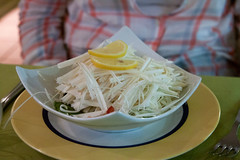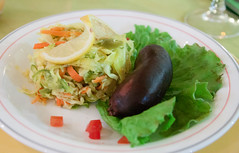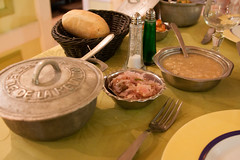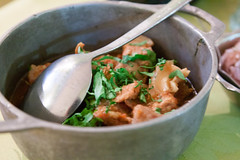Our next goal before leaving Saint-Denis was to make sure we tried one of the restaurants known for local Créole cuisine, and in the case of Saint-Denis, there’s one place that has a particularly good reputation for catering to Créole tastes over those of visiting tourists, and that’s Le Reflet des Îles.
Located about half a kilometer down Rue Pasteur (where about half of downtown Saint-Denis’s bars and restaurants are located) from the previously reviewed Zanzibar Café, just walking in you can see that it’s a popular place with both the tourists and the locals, with quite a few mainland French and Reunionnaise families all gathered around tables enjoying their rhum cocktails, la Dodo, and serving up large plates of food from various marmites (little cast metal pots traditionally used to cook the local carris, civets, and rougails) located all around the table.
So, basically, the menu at Le Reflet des Îles is “Réunion Créole”, and they’ve got a good representation of the classics (and, very unusually for a Réunion place, Le Reflet had one of the only English-language menus we saw, even if it was a classic of automatic translation) . Including rum drinks, starting off with a Ti Punch. The second-most popular drink in Reunion (after the Rhum Arrange), it’s a simple cocktail made with rhum agricole, lime, and cane syrup. While it looks fruity, it’s not, the color comes from the rhum and the cane syrup. In any case, a perfect start to the meal.
Next was a heart of palm salad. I’ve had many of these in life, usually made with canned heart of palm, and being on an island where ordering heart of palm actually involves them lugging out the giant heart of palm and shaving it to order, it does make for a particularly good rendition of the classic salad. This was also Carol’s first time try it, and she rather enjoyed it, although we both recognized that it’s not exactly an example of sustainable island agriculture (cultivating palms for heart of palm is pretty resource intensive).
And in our last review, I mentioned the Réunionnaise love of charcuturie… I continued my sausage explorations here with a particularly nice Boudin Créole (blood sausage) served up with an achard. Both halves of this dish were delicious: the blood sausage was particularly spicy and flavorful, and probably tied with the blood sausages (morcillas) that we had in Valencia at El Rall several years back. The achard was no slouch, either, being a particularly flavorful mix of cabbage and vegetables in a rich and tangy pickling sauce just oozing with turmeric, making a nice counterpoint to the blood sausage. It reminded a lot of the “curtido” (pickled carrots and cabbage) I’ve had at a lot of Salvadoran places. I’d get this again in a minute.
And for my main meal, I picked one of the cornerstones of Réunionnaise cuisine: Carri Porc. Like the previous Carris I’ve had, this was a marmite pot full of chunks of perfectly simmered pork (much like a good Carnitas) in the traditional Réunionnaise carri sauce. Like an Indian curry, it’s based on a mixture of onions, garlic, and ginger. But it’s also got the marks of Réunion flavors, with a lot of turmeric, a lot of thyme, and the local “Quatre Epices” (Four spices), which isn’t actually four spices, but the leaves of the pimenta dioica tree. You may know it better as “allspice”, but the Réunion name comes from the leaves tasting a bit like clove, ginger, nutmeg, and pepper. All of these spices applied liberally, but like I mentioned in my overview, there’s a distinct lack of hot pepper here, that being reserved for the rougail served alongside it: in this case, a pleasant mixture of onions, red pepper, vinegar, ginger, and lime. The result was a particularly pleasing carri, which, after plating up with a healthy dose of the rougail, was just the sort of spicy meal I was looking for.
Carol had a similar Carry Legine (a species of “Cod Icefish” local to the area), which while being a pleasant enough dish overall, did have a rather larger amount of bones in it than she was accustomed to. We found this to be pretty common in Réunion, along with what I typically called machete butchering (for example, a carri poulet is not likely to have the traditional chicken pieces or boneless meat sections, but is usually the entire chicken hacked into approximate 2 inch chunk, bones and all). Nothing that really bothered me, but it was a departure from my usual Indian curries back home.
Overall, we were very pleased with Le Reflet des Îles: all of the food was very well down, and it turned out to be one of the more enjoyable Réunionnaise Créole spots we visited on the trip. I’d definitely make it a point to check them out again if I return to Saint-Denis.





